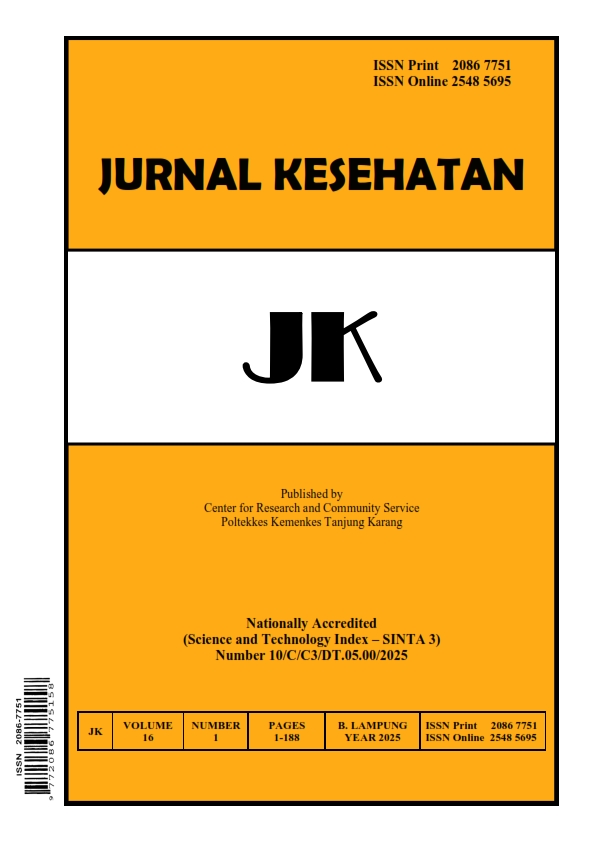Early Nutrition and Stunting: Why are Exclusive Breastfeeding and Complementary Feeding Essential for Optimal Growth?
DOI:
https://doi.org/10.26630/jk.v16i1.4951Keywords:
Child health, Complementary feeding, Toddler nutritionAbstract
This study investigates the relationship between exclusive breastfeeding, appropriate complementary feeding, and the incidence of stunting in toddlers. The objective is to identify how these nutritional practices impact child growth and development. A cross-sectional analysis was conducted involving 135 toddlers at Puskesmas Yosomulyo, utilizing a combination of interviews and questionnaires to gather data on feeding practices and health outcomes. The findings reveal that toddlers who received exclusive breastfeeding and appropriate complementary foods exhibited significantly lower rates of stunting compared to those who did not. Specifically, 33% of toddlers who were not exclusively breastfed experienced stunting, while only 19 toddlers who received appropriate complementary food were stunted. The results underscore the critical role of proper nutrition in early childhood development and highlight the need for enhanced educational programs for parents regarding feeding practices. In conclusion, promoting exclusive breastfeeding and appropriate complementary feeding is essential for reducing stunting rates and improving overall child health
References
Azriani, D., Masita, Qinthara, N. S., Yulita, I. N., Agustian, D., Zuhairini, Y., & Dhamayanti, M. (2024). Risk Factors Associated With Stunting Incidence in Under-Five Children In Southeast Asia: A Scoping Review. Journal of Health, Population, and Nutrition, 43(1), 174. https://doi.org/10.1186/s41043-024-00656-7
Bafila, P., Tiwari, K., Bisla, G., Yadav, V., & Negi, P. (2024, January). Nutritional and compositional aspects of complementary feeding. AIP Conference Proceedings (Vol. 2978, No. 1). AIP Publishing.
Christian, P., Shaikh, S., Shamim, A. A., Mehra, S., Wu, L., Mitra, M., Ali, H., Merrill, R. D., Choudhury, N., Parveen, M., Fuli, R. D., Hossain, M. I., Islam, M. M., Klemm, R., Schulze, K., Labrique, A., de Pee, S., Ahmed, T., & West Jr, K. P. (2015). Effect of Fortified Complementary Food Supplementation on Child Growth in Rural Bangladesh: A Cluster-Randomized Trial. International Journal of Epidemiology, 44(6), 1862–1876. https://doi.org/10.1093/ije/dyv155
Demirel Ozbek, Y., Celik, I., & Sahin Bilgin, A. (2025). Factors Affecting Behaviors During Complementary Feeding in Infants and Children Aged 6–24 Months. PloS One, 20(1), e0314694. https://doi.org/10.1371/journal.pone.0314694
Ekholuenetale, M., Barrow, A., Ekholuenetale, C. E., & Tudeme, G. (2020). Impact of Stunting on Early Childhood Cognitive Development in Benin: Evidence From Demographic and Health Survey. Egyptian Pediatric Association Gazette, 68(1). https://doi.org/10.1186/s43054-020-00043-x
El-Asheer, O. M., Darwish, M. M., Abdullah, A. M., & Mohamad, H. A. (2021). Complementary Feeding Pattern and Its Impact on Growth and Development of Under 2-Years Infants in Upper Egypt. Egyptian Pediatric Association Gazette, 69(17), 1–6. https://doi.org/10.1186/s43054-021-00061-3
Fauzi, N. A. F. A., Idris, I. B., Isa, Z. M., & Razib, N. F. M. (2025). Environmental Factors Contributing to Stunting among Under Six Years Old Children: A Scoping Review. International Journal of Public Health Research, 15(1), 2058–2066. https://spaj.ukm.my/ijphr/index.php/ijphr/article/view/426
Gelman, R., Whelan, J., Spiteri, S., Duric, D., Oakhill, W., Cassar, S., & Love, P. (2023). Adoption, Implementation, and Sustainability of Early Childhood Feeding, Nutrition and Active Play Interventions in Real-World Settings: A Systematic Review. International Journal of Behavioral Nutrition and Physical Activity, 20(1), 32. https://doi.org/10.1186/s12966-023-01433-1
Georgieff, M. K. (2023). Early Life Nutrition and Brain Development: Breakthroughs, Challenges and New Horizons. Proceedings of the Nutrition Society, 82(2), 104–112. https://doi.org/DOI: 10.1017/S0029665122002774
Grathima, E. F., Yunitasari, E., & Indarwati, R. (2024). The Impact of Complementary Food Interventions on Adolescence Stunting Prevention_ A Systematic Review. Indonesian Journal of Community Health Nursing, 9(2), 62–66. https://doi.org/10.20473/ijchn.v8i2.47246
Hadi, H., Fatimatasari, F., Irwanti, W., Kusuma, C., Alfiana, R. D., Asshiddiqi, M. I. N., Nugroho, S., Lewis, E. C., & Gittelsohn, J. (2021). Exclusive Breastfeeding Protects Young Children from Stunting in a Low-Income Population: A Study from Eastern Indonesia. Nutrients, 13(12). https://doi.org/10.3390/nu13124264
Health Office of Metro City. (2022). Profil Kesehatan Kota Metro Tahun 2021. Metro: Dinas Kesehatan Kota Metro.
Health Office of Lampung Province. (2022). Profil Kesehatan Provinsi Lampung Tahun 2022. Pemerintah Provinsi Lampung.
Horta, B. L., & Victora, C. G. (2013). Long-Term Effects of Breastfeeding. Geneva: World Health Organization, 74. https://iris.who.int/handle/10665/79198
Marni, M., Soares, D., Wahyudi, T., Irfan, M., & Nurul, S. (2022). Analysis Stunting Prevention and Intervention: A Literatur Review. Proceedings of the International Conference on Nursing and Health Sciences (Vol. 3, Issue 1, pp. 27–36). https://doi.org/10.37287/picnhs.v3i1.1110
Ministry of Health Republic Indonesia. (2018). Hasil Riset Kesehatan Dasar Tahun 2018. Kementerian Kesehatan RI Badan Penelitian Dan Pengembangan Kesehatan, 53(9), 1–220.
Ministry of Health Republic Indonesia. (2021). Buku Saku Hasil Studi Status Gizi Indonesia (SSGI) Tingkat Nasional, Provinsi, dan Kabupaten/Kota Tahun 2021. Kementerian Kesehatan Republik Indonesia.
Ministry of Health Republic Indonesia. (2023). Buku Saku : Hasil Survei Status Gizi Indonesia (SSGI) 2022. Kementerian Kesehatan Republik Indonesia. Kementerian Kesehatan RI.
Motee, A., & Jeewon, R. (2014). Importance of Exclusive Breastfeeding and Complementary Feeding among Infants. Curr Res Nutr Food Sci, 2(2). https://dx.doi.org/10.12944/CRNFSJ.2.2.02
Ndagijimana, A., Elfving, K., Umubyeyi, A., & Lind, T. (2025). Identification of Amendable Risk Factors for Childhood Stunting at Individual, Household and Community Levels in Northern Province, Rwanda – A Cross-Sectional Population-Based Study. BMC Public Health, 25(1087). https://doi.org/10.1186/s12889-025-22329-8
Nuradhiani, A. (2020). Pemberian ASI Eksklusif dan Makanan Pendamping ASI (MP-ASI) pada Kejadian Stunting di Negara Berkembang Exclusive breastfeeding and complementary feeding for stunting in developing countries. J. Gizi Kerja Dan Produktivitas, 2020(1), 23–28.
Onyango, A. W., Borghi, E., de Onis, M., Casanovas, M. del C., & Garza, C. (2014). Complementary Feeding and Attained Linear Growth Among 6–23-Month-Old Children. Public Health Nutrition, 17(9), 1975–1983. https://doi.org/10.1017/S1368980013002401
Permatasari, R. P., Simbolon, D., & Yunita, Y. (2024). Pencegahan Stunting melalui Pemberian ASI Eksklusif di Indonesia: Pendekatan Meta-Analisis. Amerta Nutrition, 8(1SP), 105–112. https://doi.org/10.20473/amnt.v8i1sp.2024.105-112
Ren, H., Zhou, Y., & Liu, J. (2025). Nutrition in Early Life and Its Impact Through the Life Course. Nutrients (Vol. 17, Issue 4, p. 632). MDPI. https://doi.org/https://doi.org/10.3390/nu17040632
Setiawan, A., Rahmadiyah, D. C., & Rekawati, E. (2024). Effectiveness of Family Nutrition Education on the Incidence of Stunting: Systematic Review. Indonesian Journal of Global Health Research, 6(3), 1231–1242.
Sianti, R. N., Kartasurya, M. I., & Kartini, A. (2024). Can Exclusive Breastfeeding Prevent Stunting in Lower Middle-Income Countries (Lmic)?: A Systematic Review. International Journal of Integrative Sciences, 3(1), 37–58. https://doi.org/10.55927/ijis.v3i1.7417
Tanaka, T. H. (2017). Dietary Tradition, Nutritional Theories and Science. Mathews J Nutr Diet, 2(1), 8–10.
UNICEF. (2023). Mothers Need More Support Amid Decline in Indonesia’s Breastfeeding Rates. UNICEF and WHO appeal for better workplace provisions during World Breastfeeding Week. UNICEF. https://www.unicef.org/indonesia/nutrition/press-releases/mothers-need-more-support-amid-decline-indonesias-breastfeeding-rates
Victora, C. G., Bahl, R., Barros, A. J. D., França, G. V. A., Horton, S., Krasevec, J., Murch, S., Sankar, M. J., Walker, N., & Rollins, N. C. (2016). Breastfeeding in the 21st Century: Epidemiology, Mechanisms, and Lifelong Effect. The Lancet, 387(10017), 475–490. https://doi.org/10.1016/S0140-6736(15)01024-7
WHO. (2016). Childhood Stunting: Context, Causes and Consequences. World Health Organization. https://www.who.int/publications/m/item/childhood-stunting-context-causes-and-consequences-framework?form=MG0AV3
WHO. (2018). Reducing Stunting in Children: Equity Considerations for Achieving the Global Nutrition Targets 2025. World Health Organization. https://iris.who.int/bitstream/handle/10665/260202/9789241513647-eng.pdf?sequence=1&form=MG0AV3
WHO. (2023). Exclusive Breastfeeding for Optimal Growth, Development and Health of Infants. World Health Organization. https://www.who.int/tools/elena/interventions/exclusive-breastfeeding?form=MG0AV3
WHO. (2024). World Breastfeeding Week, UNICEF and WHO Call for Equal Access to Breastfeeding Support. https://www.who.int/news/item/31-07-2024-on-world-breastfeeding-week--unicef-and-who-call-for-equal-access-to-breastfeeding-support
Downloads
Published
Issue
Section
License
Copyright (c) 2025 Yuliawati Yuliawati, Sri Lestariningsih, Yetti Anggraini, Rofana Aghniya, Non Rachmani Yustiza

This work is licensed under a Creative Commons Attribution-ShareAlike 4.0 International License.
Authors who publish in this journal agree to the following terms:
- Authors retain copyright and grant the journal right of first publication with the work simultaneously licensed under a Creative Commons Attribution License (CC BY-SA 4.0) that allows others to share the work with an acknowledgment of the work's authorship and initial publication in this journal.
- Authors can enter into separate, additional contractual arrangements for the non-exclusive distribution of the journal's published version of the work (e.g., post it to an institutional repository or publish it in a book), with an acknowledgment of its initial publication in this journal.
- Authors are permitted and encouraged to post their work online (e.g., in institutional repositories or on their website) prior to and during the submission process, as this can lead to productive exchanges and earlier and greater citations of published work.












